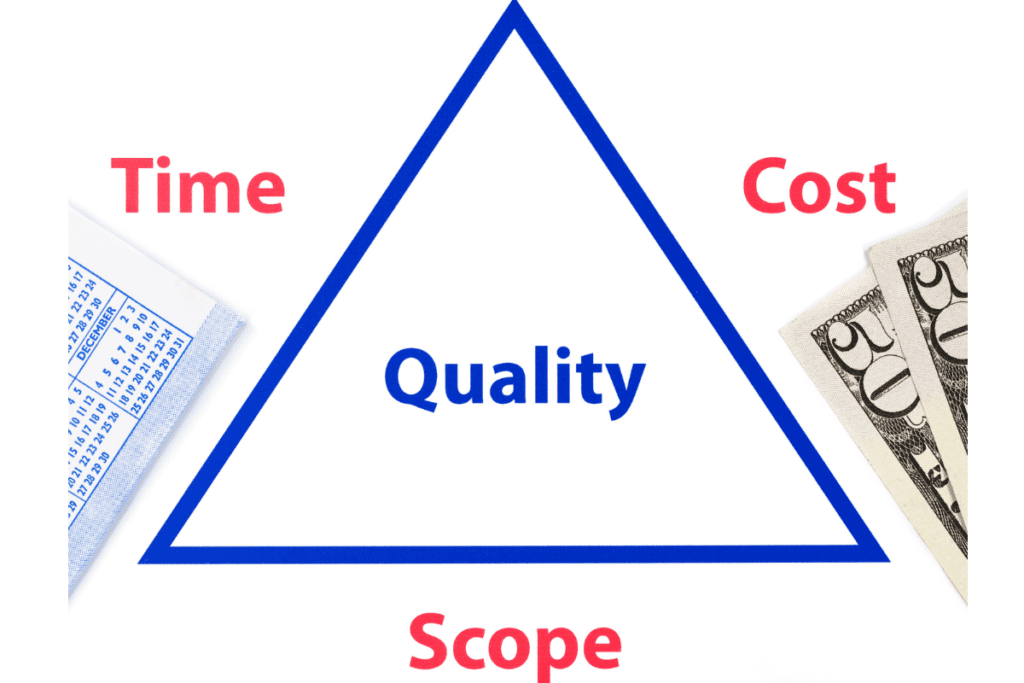Unlocking Success in Project Management: Navigating the Triple Constraints of Time, Cost, and Scope for Optimal Results
Introduction to the Triple Constraint Theory
Unveiling the Enigma: The Triple Constraint in Project Management
In the vast landscape of project management, the triple constraint stands as a formidable force that guides and shapes every endeavor. Mastering the Triple Constraints of project management is a concept that encapsulates three crucial components: time, cost, and scope.
These elements form an intricate relationship that deeply influences the outcome and success of any project. Understanding the triple constraint is essential for project managers as it provides a framework to balance these critical factors and navigate through complexities to complete the project.
The Project Management Triangle: Time, Cost, and Scope
Let’s delve into each component of the triple constraint to gain clarity about their significance for project management.
Time: Time is an omnipresent factor in any undertaking. It represents how long it takes to complete a project successfully. Meeting deadlines is not only crucial for client satisfaction but also impacts resource allocation and overall project efficiency. Effective time management ensures that tasks are completed within designated timescales while accounting for potential delays or unforeseen circumstances.
Cost: The financial aspect comes into play with cost – how much money will be invested throughout the course of a project? Accurate budgeting helps in allocating resources efficiently, managing expenses effectively, and maintaining financial stability during project execution. Project managers know the importance of estimating project tasks and ensuring the project team inputs time into the timesheet correctly Monitoring expenses allows teams to identify deviations from the projected budget promptly.
Scope: Scope refers to defining what needs to be accomplished in a given undertaking. A well-defined scope outlines objectives, deliverables, tasks, timelines, required resources, and expected outcomes of a project. Changes in the scope can significantly impact both time and cost considerations; therefore, managing scope effectively ensures alignment with initial goals while accommodating necessary modifications.
The three components of time, cost, and scope establish what is commonly known as “The Triple Constraint Triangle” or “The Iron Triangle” model in project management circles. They form an interconnected system where adjustments in one component might also affect the other two.
Balancing these elements is crucial for achieving project objectives while maintaining overall quality and stakeholder satisfaction. Now that we have acquainted ourselves with the fundamentals let us embark on an exploration of how to manage the triple constraint effectively.

Understanding Time Management
The Importance of Setting Realistic Project Timelines
Time, without a doubt, is one of the most crucial aspects of any project. As a project manager, it is imperative to establish realistic timelines right from the start.
Why? Because setting overly ambitious or impractical deadlines can lead to a series of problems along the way.
If you commit to unrealistic timelines, you risk placing unnecessary pressure on your team members and compromising the quality of the final deliverable. To create accurate project timelines, you must fully grasp the scope and complexity of each task involved.
Take into account any potential roadblocks or dependencies that might affect your team’s ability to meet deadlines. Communicate with your team members to ensure they have enough time to complete their tasks without rushing or sacrificing quality.
Techniques for Effective Time Estimation and Scheduling
When it comes to time estimation and scheduling, several techniques can help you streamline processes and keep your project on track. Two popular methods commonly used are Critical Path Method (CPM) and Program Evaluation Review Technique (PERT).
The Critical Path Method (CPM) involves determining the critical path – which is essentially identifying the sequence of activities that directly impacts project completion time – by evaluating task durations and dependencies. By identifying critical tasks, you can pinpoint areas where delays could potentially impact overall project delivery.
On the other hand, Program Evaluation Review Technique (PERT) utilizes three-time estimates for each task: pessimistic (the longest duration), optimistic (the shortest duration), and most likely. PERT then calculates an expected duration taking into account these estimates weighted by their probabilities.
Strategies to Mitigate Schedule Risks and Delays
Mitigating schedule risks and delays should be a priority for any project manager aiming for success. One effective strategy involves implementing buffering techniques like adding slack time to the project schedule. By padding your timeline with some extra time, you create a buffer to accommodate unexpected delays or disruptions.
This not only helps in maintaining a realistic schedule but also provides your team members with some breathing room to handle unforeseen challenges. In today’s fast-paced business environment, agile methodologies have gained immense popularity for their flexibility and adaptability.
Incorporating agile practices into your project management approach allows for iterative planning and continuous collaboration, ensuring that adjustments can be made swiftly when required. Agile methodologies empower teams to respond to changing circumstances while still meeting project objectives.
Remember, managing time effectively is essential to keep your project on track and deliver high-quality results. By employing techniques such as CPM and PERT, as well as implementing strategies like buffering and embracing agile methodologies, you can confidently navigate the time aspect of the triple constraint triangle and achieve successful project outcomes.
Navigating Cost Management: Why it’s Important for Project Success
Estimating project costs accurately
Accurately estimating project costs is crucial for successful cost management. It involves identifying both direct and indirect costs associated with the project. Direct costs are expenses directly attributable to the project, such as materials, equipment, and labor.
On the other hand, indirect costs are expenses that cannot be tied directly to a specific project activity but still contribute to the overall cost, like overhead expenses or administrative fees. To estimate project costs accurately, it is vital to consider historical data and benchmarks.
Analyzing data from previous similar projects can provide valuable insights into potential cost drivers and trends. By studying past projects’ expenditures and comparing them with the current one’s scope and requirements, you can make more informed estimates.
Utilizing historical data and benchmarks for cost estimation
Historical data plays a pivotal role in estimating project costs. It provides a foundation for establishing realistic budgets by drawing on previous experiences and outcomes.
By analyzing historical records of similar projects within your organization or industry, you can identify patterns that will aid in predicting potential expenses. Benchmarks also serve as useful references during cost estimation.
These benchmarks are established metrics related to different activities or stages of a project that assist in determining expected costs based on industry standards or best practices. For example, if your organization regularly conducts software development projects, you may refer to benchmarked figures for coding hours per line of code or testing hours per module.
Controlling project expenses efficiently
Once the estimates are established, controlling project expenses becomes crucial. Tracking actual expenditure against budgeted amounts helps identify any deviations early on and take necessary actions to mitigate risks.
One effective technique for managing costs is implementing Earned Value Management (EVM). EVM integrates time-phased budgeting with actual work progress to assess how well resources are being used throughout the project.
This technique enables project managers to monitor and control costs while evaluating the project’s overall performance. By analyzing the cost and schedule variances calculated through EVM, project managers can proactively take corrective measures.
They can identify potential cost overruns, schedule delays, or resource constraints and make informed decisions accordingly. EVM provides a comprehensive overview of the project’s financial health and allows for timely adjustments to keep it on track.
Cost management is an essential aspect of successful project execution. Accurate cost estimation based on historical data and benchmarks lays the foundation for effective budgeting.
By closely monitoring actual expenses against planned budgets and implementing techniques such as Earned Value Management, you can exercise control over costs throughout the project lifecycle. This ensures that your project stays within budgetary limits while delivering a high-quality final deliverable.
Using the Triple Constraint Triangle to Manage Scope Effectively
Setting the Foundation for Success
In order to effectively manage the triple constraint, project managers must start by defining clear project objectives and deliverables. This is crucial as it sets the foundation for a successful project. When objectives and deliverables are clearly established, it becomes easier to align the project’s scope with its goals. To accomplish this, conducting a thorough stakeholder analysis is paramount.
Stakeholders are individuals or groups who have a stake in the project or will be affected by its outcome. By identifying and involving key stakeholders from the beginning, project managers can gain valuable insights into their expectations, requirements, and potential concerns. This helps in shaping a well-defined scope that meets stakeholders’ needs while avoiding scope creep – uncontrolled expansion of project goals.
Once stakeholder analysis is complete, it’s time to develop a comprehensive scope statement. This statement clearly outlines what will be included within the project’s boundaries and what will not. It captures all relevant details such as deliverables, key features, exclusions, assumptions, and constraints.
A solid scope statement serves as a guide throughout the duration of the project and keeps everyone on track towards achieving desired outcomes. This is key to help make the project a success.
Before starting the implementation of a project, make sure that you have a clear documented understanding of the triple constraint structure. The Project Sponsor and stakeholders should agree of which one of the project constraints in the project triangle has the most flexibility. Solidifying this understanding will serve as the foundation for risk mitigation decisions later in the project.
Staying Agile in an Evolving Environment
During any project’s lifecycle, changes in scope are inevitable due to various factors like emerging requirements or external influences. To keep your project on track amidst these changes, establishing a change control process becomes crucial.
The change control process sets rules for evaluating proposed changes in scope before implementation. Project managers should carefully assess each requested change against its impact on time and cost constraints as well as alignment with overall objectives. By doing so, they can make informed decisions about whether to accept or reject scope changes. Evaluating impact primarily involves assessing the effects on the project’s timeline and budget.
A change that expands the scope may result in additional tasks, longer duration, or increased costs. Conversely, a change that reduces the scope may shorten timelines or lead to cost savings. Project managers must carefully evaluate these impacts and communicate them effectively to stakeholders. It is important to note that an effective change control process also needs to consider the risks associated with scope changes. For instance, modifying deliverables might affect quality or resource allocation.
By anticipating and mitigating potential risks, project managers can proactively minimize any negative impact that changes in scope may have on the overall project success. Managing scope effectively is a vital component of successful project management. Clearly defining objectives and deliverables through stakeholder analysis and a comprehensive scope statement provides a solid foundation for any project. Additionally, establishing a robust change control process helps navigate through inevitable changes in scope without sacrificing time or budget constraints.
By striking a delicate balance between adhering to initial plans while remaining flexible enough to accommodate necessary adjustments, project managers can ensure smoother project execution and ultimately achieve better outcomes for all stakeholders involved.
Controlling the Triple Constraints of Project Management
Trade-offs between time, cost, and scope
In the world of project management, finding the delicate balance between time, cost, and scope is a constant challenge. These three constraints are closely intertwined and have a direct impact on the success or failure of a project.
When one constraint is adjusted, it inevitably affects the others. For instance, if you need to accelerate a project schedule to meet an urgent deadline, it may require additional resources and potentially increase costs.
Alternatively, reducing costs might involve cutting down on certain features or functionalities (scope). Therefore, as a project manager, it is crucial to carefully evaluate trade-offs when making decisions regarding these constraints.
Exploring the concept of “fast, cheap, good” triangle
The “fast, cheap, good” triangle model provides an insightful framework for understanding the relationship between time, cost and quality in project management. This model suggests that you can only pick two out of these three factors: fast delivery (time), low cost or budget (cost), and high-quality final deliverables (good). If you aim for fast delivery at low cost without compromising quality, it becomes challenging to achieve all three simultaneously.
There will always be some trade-offs involved. Let’s say you want your team to complete a critical project within tight deadlines (fast) while keeping costs low. Project management experts agree, project managers need to use the project management triangle, control the triple constraints, and know which one of the three constraints has flexibility. Otherwise, quality of the project will suffer, or you will be in for budget overruns, schedule slippages and/or project scope creep.
In such cases where time is prioritized over other factors like budget or quality compromises might occur along the way. You may have to streamline processes so that they are more efficient but sacrifice some aspects of quality control or extensive testing procedures.
Analyzing different scenarios for adjusting constraints
Project managers must analyze various scenarios when adjusting constraints to maintain equilibrium in their projects. By examining each constraint individually and considering potential changes or adjustments in one area while keeping others constant can help identify possible solutions.
For example, if a client establishes a strict deadline (time constraint), the project manager can assess the scope and identify possible reductions or prioritize specific features to meet the deadline without increasing costs significantly. Similarly, when budget constraints are particularly stringent, project managers might explore alternative approaches or seek more competitive pricing from suppliers to maintain scope while keeping costs under control.
Flexibility in adjusting constraints can provide opportunities for innovation and creative problem-solving. Managing the triple constraint is an ongoing process that requires careful consideration of trade-offs between time, cost, and scope.
Using the “fast, cheap, good” triangle model as a guide helps project managers understand that there are inherent limitations in achieving all three objectives simultaneously. By analyzing different scenarios and making strategic adjustments within each constraint, project managers can find optimal solutions to keep their projects on track and satisfy both stakeholders’ expectations and project requirements.
Stakeholder Communication to Make the Triple Constraint Work
Understanding stakeholder expectations
When it comes to managing the triple constraint, also known as the Project Management Triangle, understanding the expectations of stakeholders is crucial. Project stakeholders are individuals or groups who have a vested interest in the project and can directly influence its success.
They can include clients, team members, sponsors, and even end-users. To effectively manage stakeholder expectations, it is essential to engage them early on in the project and gather their input.
By doing so, you can gain a better understanding of their needs, concerns, and desired outcomes. This insight will allow you to align your project goals with the expectations of those who have a stake in its success.
Identifying key stakeholders
Identifying key stakeholders is another important aspect of managing the triple constraint successfully. Key stakeholders are individuals or groups, both in and outside the core project team, who hold significant influence over the project’s outcome or have a particular interest in its results. They may have decision-making power, access to resources, or expertise that is critical for project execution.
Identifying these key stakeholders early on enables you to engage with them actively throughout the project lifecycle and ensure that their needs are met appropriately. To identify key stakeholders effectively, conduct a thorough stakeholder analysis by considering anyone who may be affected by or affect your project.
This includes not just those directly involved but also those indirectly impacted by its outcome. Clearly define their roles and responsibilities within the project context so that you can properly address their expectations.
Conducting Regular Communication Updates
Regular communication updates play an integral role in managing the triple constraint successfully. Effective communication with stakeholders ensures that everyone involved is well-informed about key decisions, progress updates, and any changes that may occur throughout the duration of the project. These status updates include how, and which information will be shared among team members and stakeholders alike.
This could include weekly status meetings, email updates, or even through a dedicated project management software. By maintaining open lines of communication, you can address concerns promptly, gather feedback, and maintain stakeholder buy-in.
By prioritizing stakeholder engagement and communication throughout the project lifecycle, you can foster a collaborative environment that enhances the success of the project. Remember, managing the triple constraint is not just about delivering on time and within budget; it is also about ensuring that stakeholders feel heard and valued.
Conclusion
Successfully balancing these three constraints requires more than just controlling the time, cost, and scope of a project. It necessitates understanding stakeholder expectations and actively engaging with them throughout the project lifecycle. By identifying key stakeholders early on, conducting thorough stakeholder analysis, and establishing regular communication channels, you can navigate the challenges that may arise when managing these constraints.
Remember that effective communication is at the heart of successful stakeholder engagement. By keeping stakeholders informed and addressing their concerns promptly, you create an environment that fosters collaboration and ensures everyone’s needs are met. Keeping the dreaded scope creep at bay and managing project progresses is the point of the triangle.
So as you embark on your own projects in the future, keep in mind not only how to control the triple constraint, but also how to engage stakeholders effectively. By doing so, you’ll increase your chances of delivering high-quality results while leaving a positive impact on those involved.
If you liked this article, remember to subscribe to MiamiCloud.com. Connect. Learn. Innovate.








